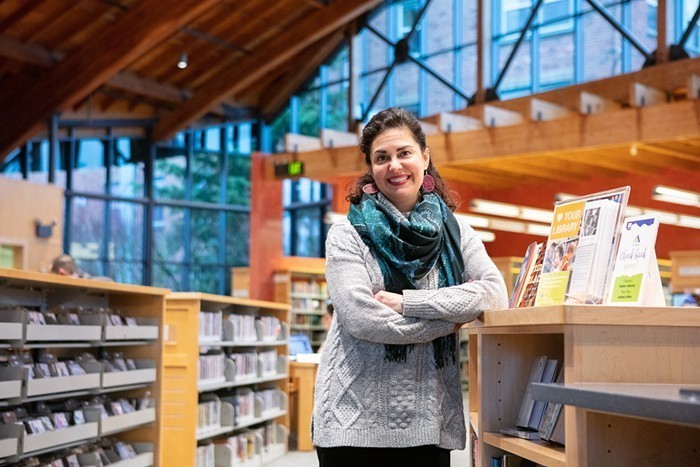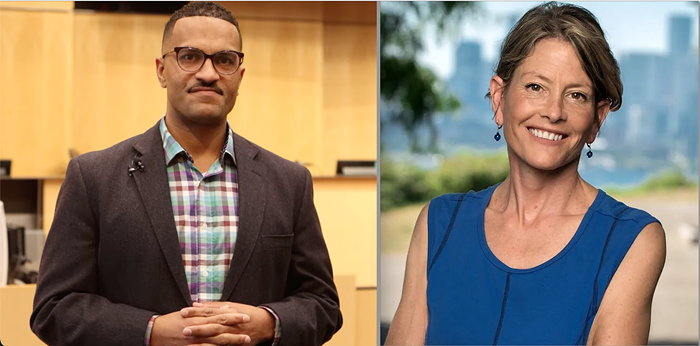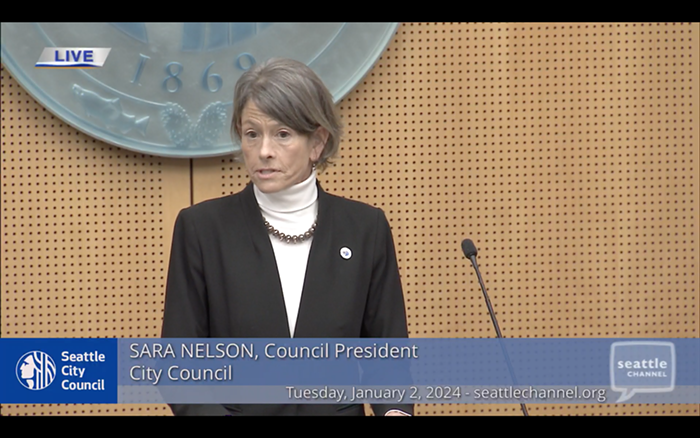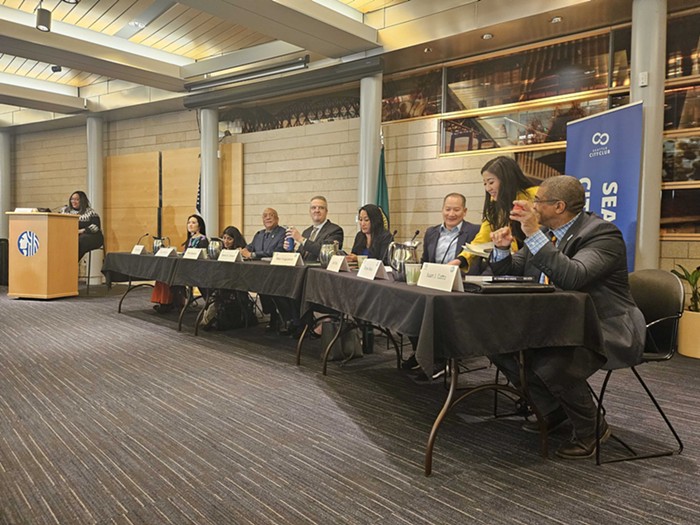
Roller skates, banana suit costumes, giant flapping metal birds, charcoal sketches, pothole puddles, drag queens, a mad scientist electro-pop band, watercolor paintings, a man in a rainbow vest waving a ribbon baton for hours on end, a pirate ship blasting a bad EDM remix of “Black Hole Sun”, incorrectly punctuated graffiti, a middle-aged man blasting Nirvana on his Bluetooth speaker, Seattle’s cottage nostalgia industry operating in full swing—last weekend’s Viaduct festival had just about everything except the one thing the viaduct was built for: cars. (With the exception of blinged-out art cars on display.)
Instead of 90,000 vehicles drowning out the waterfront at 80 decibels, 100,000 people showed up to stroll along the Alaskan Way Viaduct on Saturday. That six-figure crowd ranks this past weekend’s farewell festival among the city’s largest public events this decade right up there with the 2017 Womxn’s March on Seattle and the 2014 Seahawks victory parade.

With the long overdue reality check of the viaduct actually closing, the tunnel actually opening, and the replacement Alaskan Way stretching as wide as eight lanes at points, there has been a lot of rehashing of decade-old debates that have been settled. The money has been spent, the decisions have been made, the fucking tunnel has finally been dug. Everyone is just as pissed off as they were in 2009, though Danny Westneat at the Seattle Times wants to knock heads together and declare that both sides were right. (And save the Battery Street Tunnel from rubble while he’s at it.)
But here’s a fresh idea that doesn’t require time travel to the Obama-era decisions we’re living with today, proven by the more than 10 percent of Seattle’s population that showed up on a single day in a single place: make more room for people on the waterfront by closing a portion of the new Alaskan Way to cars on summer weekends.
We already close a stretch of Lake Washington Boulevard on Sundays from May-September and have tepidly experimented with pedestrian-only People Streets on Capitol Hill. But in the city of endless pilot programs and community outreach, Saturday accomplished both in one fell swoop and it was a smashing success. Simply put, people loved the chance to hang out on the waterfront and linger.
Yes, we will have lots of new public space on the waterfront once the viaduct comes down and Saturday’s enormous crowd was certainly fueled by the limited-time-only novelty of a one-day event, but given how many people turned out on a cloudy, chilly February day lacking the viaduct’s postcard mountain views, imagine how much a beautiful summer day will entice the public. In a growing city with limited downtown parks, a Sunday closure on Alaskan Way will offer a different kind of public space than the new Pier 62. A place you can teach your kid to ride a bike, pretend it’s the '90s again on your rollerblades, watch a HonkFest West street band parade down the boulevard, or just set up a lounge chair and soak in the sun.

Seattle’s viaduct vacillation has been compared to many peer cities around the world: from Boston’s Big Dig to San Francisco’s Embarcadero to Seoul’s Cheonggyecheon. But we’re missing two spot-on, if unlikely, comparisons from Brazil.
First, the Viaduct festival was just like every weekend on São Paulo’s Big Worm (Minhocão in Portuguese, but yes that is the English translation). I spent three years in Brazil and some very memorable afternoons on that hideous highway, which becomes a bare-bones High Line on Saturdays and Sundays simply by closing the on- and off-ramps to cars, costing almost nothing. No fancy landscape architecture, no expensive food trucks, just everyday citizens getting a piece of public space in a concrete jungle far more extreme than Seattle. People rollerblade, bike, draw with sidewalk chalk, set up inflatable kiddie pools, barbecue.
Some Seattleites wanted to do the same for the viaduct, to no avail. It turns out we could have for 60 years with the stroke of a “closed” sign on weekends when we don’t have workday transportation needs. We screwed that up, but Saturday was a sweet taste of what could have been.
Now that the viaduct is a goner, our best model comes from Rio de Janeiro, where Sundays see one-half of the oceanfront Avenida Atlântica—a waterfront boulevard similar in width to the future Alaskan Way Viaduct—closed to traffic. Some days it felt like the entire city was out there. Even with a tropical beach just steps away, people loved biking, walking, jogging, parading, and driving toy cars.
I saw a similar dynamic at work on the viaduct. Not so much in the prearranged art installations, which felt overprogrammed at the north end where the art cars, Culture Hustlers’ trailer park, live band, and bell-jangling folk dancers all collided, but in the more spontaneous moments: a watercolor artist working on a sunset painting, a charcoal sketcher drawing the city skyline, two girls teetering on roller skates, people peering into the gaps between roadway slabs and marveling at the two-inch-wide view all the way down to the street below. At one point I climbed an emergency stairwell out of the thousands wandering the Battery Street Tunnel and emerged onto a quiet side street in Belltown like Super Mario traveling through a tube.
For one day, the viaduct became the elevated park some of us wanted—perhaps even a concrete vision of the Seattle Commons many of us now pine for as an alternative to Amazonia, or a premonition of what a Lid I-5 Park could achieve.
Closing part of Alaskan Way to traffic may not be as entirely magical as frolicking up on the viaduct, but it’s eminently manageable. Give the waterfront over to the people.



















